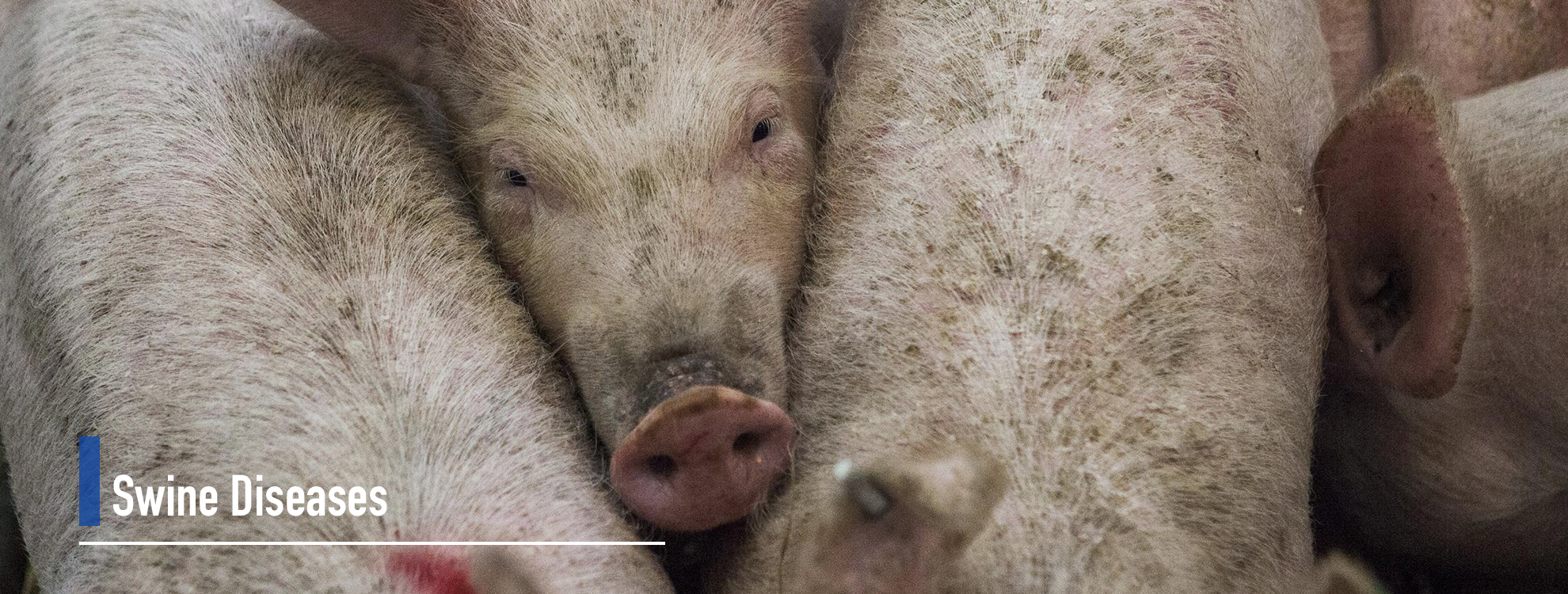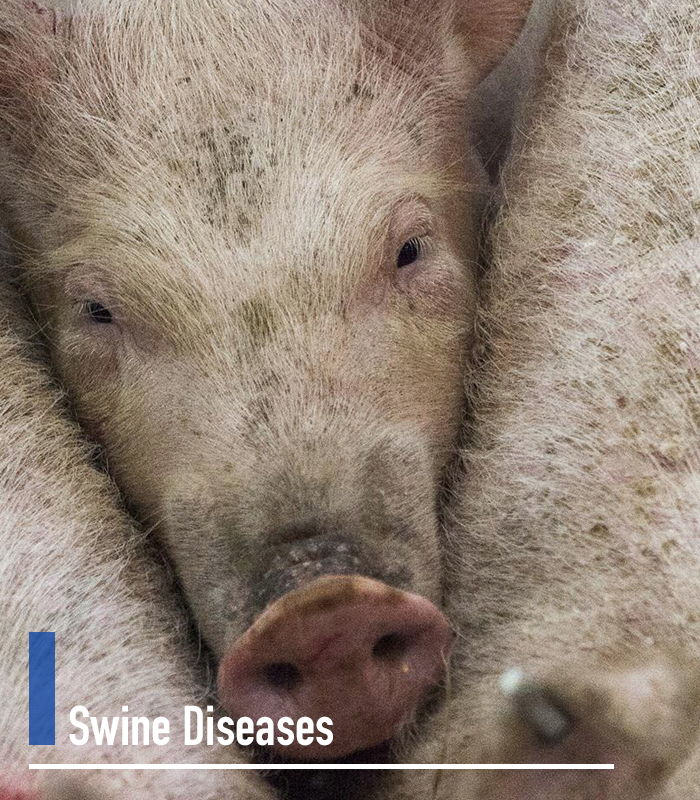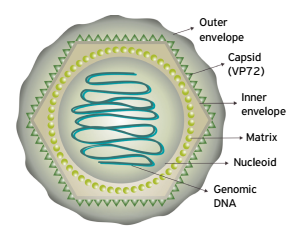

ASFV is a large, icosahedral, double-stranded DNA virus with a linear genome of 189 kilobases containing more than 180 genes. The number of genes differs slightly among different isolates of the virus. ASFV has similarities to the other large DNA viruses, e.g., poxvirus, iridovirus, and mimivirus. In common with other viral hemorrhagic fevers, the main target cells for replication are those of monocyte, macrophage lineage. Entry of the virus into the host cell is receptor-mediated, but the precise mechanism of endocytosis is presently unclear. Based on sequence variation in the C-terminal region of the B646L gene encoding the major capsid protein p72, 22 ASFV genotypes (I–XXIII) have been identified. All ASFV p72 genotypes have been circulating in eastern and southern Africa.
Genotype I has been circulating in Europe, South America, the Caribbean, and western Africa. Genotype VIII is confined to four East African countries. After the re-introduction of ASF Genotype II isolates into Georgia in 2007, the disease spread from Eastern to Western Europe and then jumped first up to Mongolian borders and later into China in August 2018, spreading out of control and reaching different countries of Southeast Asia.

Porcine reproductive and respiratory syndrome (PRRS) is a widespread viral disease that affects domestic pigs, which was first recognized in the United States in 1987. Symptoms include reproductive failure, pneumonia and increased susceptibility to secondary bacterial infection. Multiple strains of the virus with considerable variation in virulence explain the broad spectrum of clinical manifestations of the disease. Nonetheless, it has become the most important disease in intensively raised pigs in North America and Europe, and its importance is dramatically increasing in Asia. Each year, PRRS costs the United States $560 million by causing reproductive failure in adult females and deadly pneumonia in nursing pigs.


Porcine epidemic diarrhea virus (PEDV) causes acute diarrhea, vomiting, dehydration and high mortality in neonatal piglets. The disease was reported in the European and Asian pig industries over the last 30 years. Since October 2010, a new variant strain of porcine epidemic diarrhea has appeared, which has been widespread in China and other major pig-raising countries in the world, and its prevalence in East Asia and North America is severe, causing large economic losses to the farms


PCV2 is the primary causative agent of several syndromes collectively known as porcine circovirus‐associated disease (PCVAD). Many of the syndromes associated with PCVAD are a result of coinfection with PCV2 virus and other agents such as Mycoplasma and porcine reproductive and respiratory syndrome virus. PCV2 infection is present in every major swine‐producing country in the world, and the number of identified cases of PCVAD is rapidly increasing. In the United States, the disease has cost producers an average of 3–4 dollars per pig with peak losses ranging up to 20 dollars per pig.


ASFV is a large, icosahedral, double-stranded DNA virus with a linear genome of 189 kilobases containing more than 180 genes. The number of genes differs slightly among different isolates of the virus. ASFV has similarities to the other large DNA viruses, e.g., poxvirus, iridovirus, and mimivirus. In common with other viral hemorrhagic fevers, the main target cells for replication are those of monocyte, macrophage lineage. Entry of the virus into the host cell is receptor-mediated, but the precise mechanism of endocytosis is presently unclear. Based on sequence variation in the C-terminal region of the B646L gene encoding the major capsid protein p72, 22 ASFV genotypes (I–XXIII) have been identified. All ASFV p72 genotypes have been circulating in eastern and southern Africa.
Genotype I has been circulating in Europe, South America, the Caribbean, and western Africa. Genotype VIII is confined to four East African countries. After the re-introduction of ASF Genotype II isolates into Georgia in 2007, the disease spread from Eastern to Western Europe and then jumped first up to Mongolian borders and later into China in August 2018, spreading out of control and reaching different countries of Southeast Asia.

Porcine reproductive and respiratory syndrome (PRRS) is a widespread viral disease that affects domestic pigs, which was first recognized in the United States in 1987. Symptoms include reproductive failure, pneumonia and increased susceptibility to secondary bacterial infection. Multiple strains of the virus with considerable variation in virulence explain the broad spectrum of clinical manifestations of the disease. Nonetheless, it has become the most important disease in intensively raised pigs in North America and Europe, and its importance is dramatically increasing in Asia. Each year, PRRS costs the United States $560 million by causing reproductive failure in adult females and deadly pneumonia in nursing pigs.


Porcine epidemic diarrhea virus (PEDV) causes acute diarrhea, vomiting, dehydration and high mortality in neonatal piglets. The disease was reported in the European and Asian pig industries over the last 30 years. Since October 2010, a new variant strain of porcine epidemic diarrhea has appeared, which has been widespread in China and other major pig-raising countries in the world, and its prevalence in East Asia and North America is severe, causing large economic losses to the farms


PCV2 is the primary causative agent of several syndromes collectively known as porcine circovirus‐associated disease (PCVAD). Many of the syndromes associated with PCVAD are a result of coinfection with PCV2 virus and other agents such as Mycoplasma and porcine reproductive and respiratory syndrome virus. PCV2 infection is present in every major swine‐producing country in the world, and the number of identified cases of PCVAD is rapidly increasing. In the United States, the disease has cost producers an average of 3–4 dollars per pig with peak losses ranging up to 20 dollars per pig.


